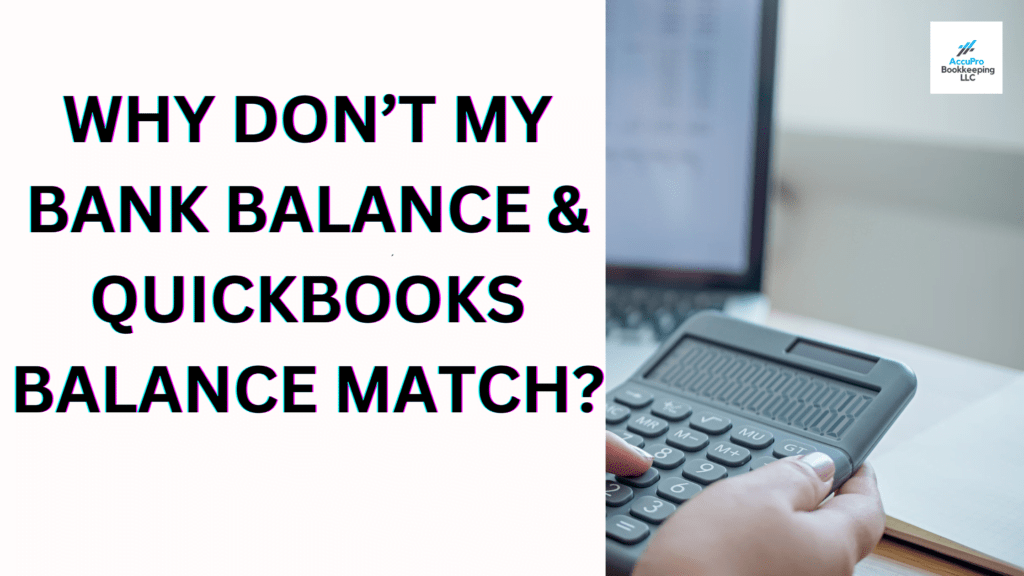Why don’t my bank balance and QuickBooks balance match?

Precision is paramount in the world of accounting. When It comes to tracking your business income & expenses, QuickBooks has emerged as a leading cloud based accounting software. However, one issue that is common among QuickBooks users is the mismatch between their QuickBooks balance and their bank account balance. There can be several reasons why these two balances don’t match. In this article, we will be exploring the reasons behind this discrepancy & provide helpful solutions to fix this discrepancy.
Outstanding Checks
Your QuickBooks & Bank Account Balance will only match If you don’t have any outstanding checks. These are the transactions that are already recorded in QuickBooks but they haven’t actually cleared the bank yet. Outstanding Checks causes your registered balance to be different from your actual bank balance.
For Example, Let’s suppose your bank balance is $5000 but you have an outstanding check for $2000. In this case, QuickBooks will enter the check in QuickBooks register reducing balance by $2000 causing Check to look like as It has already cleared the bank. However, Bank Account Balance will continue to remain as $5000 until the outstanding check is cleared by the bank.
Handwritten Checks
Handwritten checks that have been cleared by the bank but not yet entered into QuickBooks register can also cause the discrepancy between Bank Account & QuickBooks Balance.
New Transactions
If your bank account is linked to QuickBooks for automatic transaction import, any new transactions that appear in the ‘For Review’ tab and are not yet categorized can cause discrepancies between your QuickBooks and bank account balances. This is because these transactions have not been officially recorded in QuickBooks. By categorizing/adding them, you can update the balance in QuickBooks Online and correct the discrepancy.
Duplicate Transactions
You may have incorrectly added a transaction in the QuickBooks register twice by mistake. An Easy way to fix this problem is by not finalizing monthly reconciliation of bank accounts until you have figured all of them out. This way you can go back to each one & finalize it. You will be stunned at the amount of errors you’ll catch this way.
Deleted Transactions
Deleting a reconciled transaction can also cause discrepancy between QuickBooks & Bank Account Balance. QuickBooks doesn’t allow you to restore a deleted transaction. However, you can re-enter a transaction in QuickBooks register using Audit log.
Credit Card & Loan Accounts:
Credit card & Loan accounts have an inverse effect on your books compared to traditional bank or asset accounts. This often results in a negative value in the ‘Bank Balance’ column for these accounts. However, the crucial figure to monitor is the ‘Balance’ column, which ideally should be in the positive.
If you have a negative balance, it’s an indication to review your transaction history and reconciliation procedures to resolve any discrepancies with your credit card balance. If you’re utilizing an automatic transaction import feature, it’s important to verify whether you’ve added the payment from the bank account and correspondingly matched it on the credit card end (or vice versa). By not following these steps, you might be mistakenly adding the same transaction from both the bank and the credit card or liability account, leading to duplicate records. To correct this, undo one of the duplicate transaction, and then match it.
Need Help with your QuickBooks?
If you’re having trouble identifying or correcting errors in QuickBooks, We would love to help you!
At Accupro Bookkeeping, we help in resolving such errors with our specialized QuickBooks services. Whether it’s catch-up bookkeeping, a deep dive QuickBooks Clean-up , consistent monthly bookkeeping, managing AR/AP ensuring your books are accurate and up-to-date.